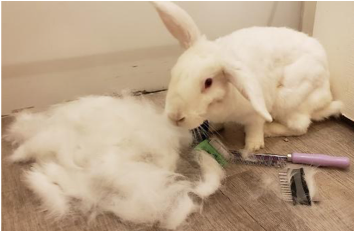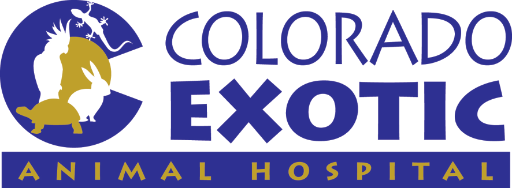Osteoarthritis and Senior Rabbit Care
As rabbits age, it is common for them to develop conditions that make it challenging for them to go about day-to-day activities. Most commonly, rabbits will develop osteoarthritis or degenerative joint disease making it difficult for them to ambulate and groom themselves. Osteoarthritis is a painful condition of the joints that results in inflammation and a decreased range of motion. Most affected joint spaces are the knees (stifles) and the area where the spine meets the pelvis (lumbosacral). Large breed rabbits, obese rabbits, and those who have sustained a musculoskeletal injury in the past have an increased risk for this condition. Some signs that your rabbit may need a veterinary exam regarding osteoarthritis and senior care are muscle wasting over the spine/pelvis, hunched posture, reluctance to move or decrease in physical activity, cecotrophs being left uneaten, urine/fecal staining of the fur, and/or a decreased appetite. The following information is meant as a guide to help rabbit owners promote comfort and cleanliness for their senior rabbits.
Veterinary exam and pain medication
A veterinary examination is the most important step in caring for your senior rabbit. A veterinarian will be able to evaluate your furry loved one for any underlying medical conditions and may find things you are unaware of. If warranted, they will make recommendations for diagnostic tests, radiographs, and/or treatments. Pain/anti-inflammatory medication is often used in rabbits with arthritis but there are many other things to consider before starting this. A supplement we recommend to promote joint health is Oxbow’s Natural Science Joint Support. If you would like to schedule an exam for your rabbit, please give us a call!
Bedding
Rabbits with arthritis will often sit in their urine or feces after they pass it because it is painful for them to move. One way we can help keep them clean is by keeping them on padded/absorbent bedding that allows them to sit in one place for a long period of time without becoming soiled or getting bed sores. There are a lot of options on the market such as fleece or washable mats. To see more options, please visit this website. Ultimately, any absorbent bedding that promotes traction is perfect! Piling hay in the litter box is also helpful.Just be sure to avoid pine and cedar due to the strong aromatic components of these substrate that can cause respiratory problems in rabbits and other small furry animals.
Grooming
As rabbits age and get arthritis, they often are not as capable of grooming themselves. It is very important to brush your rabbit at least 1-2 times per week. Matting in senior rabbits is very common and unfortunately a very painful condition. Lack of grooming in a senior rabbit can result in wounds and skin infections. Be sure to focus on areas along their back, around their tail, and under their back legs. We recommend gently picking your rabbit up to inspect their bellies and hind end once a week to prevent any matting from going unnoticed. For brushes, we recommend Small Pet Select Pet HairBuster Comb and FURminators.

Urine scald - What is it and how to prevent it?
Urine scald is the result of urine sitting on the skin/fur for extended periods of time resulting in a chemical burn of the skin. This can cause secondary skin infections, inflammation, and a lot of pain. In order to prevent it, make sure you keep your furry friend on absorbent bedding (see above) and as dry as possible. To remove urine from fur, do NOT give your rabbit frequent baths although sometimes a ‘butt bath” is needed. Instead of this, we recommend organic/natural baby wipes to clean urine soaked fur. If your rabbit's fur is past the point of being able to clean with baby wipes, please contact us to schedule an appointment for an exam and sanitary clean/clipping of fur. Shaving the fur is a very important component of managing this condition.
Enclosure
For senior rabbits, especially those with arthritis, it is recommended to provide them as much traction as possible and ensure there are no areas in the enclosure requiring them to jump to get to food/water. We recommend setting them up in a large, one level enclosure and having shallow litter boxes. In the photo, you can see a plastic under the bed container with a cut out where the rabbits enter being used as a litter box. An easy way you can section off an area for your rabbit is to purchase wire cubby squares and use them as a fence rather than for storage. You can see an example of this in the picture as well. It is also very important to ensure hay, water, and pellets are easily accessible. We recommend them being at eye level for all rabbits as standing up on their back legs to reach food can be painful if they have arthritis. Water bowls are recommended instead of or in addition to a bottle.

Acupuncture
Just like it works in people, acupuncture is a modality we can use to help with chronic pain in our rabbit friends. This should be performed by a certified professional. Ask your veterinarian for a referral to an acupuncturist comfortable working with rabbit patients.
Laser Therapy
Laser therapy is a low stress treatment with minimal to no side effects that can help reduce chronic pain associated with osteoarthritis. It targets areas of inflammation, pain, and infection thus decreasing inflammation and pain and accelerating healing. This is recommended to be performed 2-3 times weekly to as needed, and is performed by a technician once prescribed by a doctor. This is a service we provide at our hospitals.
TLC
Overall, the most important thing for your senior rabbit is provide them with tender, loving care! You are their bunny parents and know them best. Adapt their lifestyle to their needs, keep a close eye on their weight and appetite, and spoil them with all the love you possibly can. If you ever have any questions about caring for your rabbit or want to have a veterinarian examine them, please do not hesitate to reach out to us. That is what we are here for!


